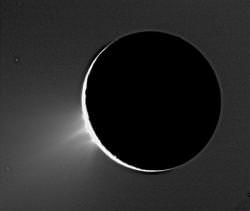Yesterday I blogged about how particles jetting from Enceladus find their way to Saturn’s A-Ring. Now there’s a new report that models how ice and vapour come pouring out of cracks on Enceladus’ surface in the first place.
Since Cassini first discovered jets of water ice blasting out of Saturn’s moon Enceladus, scientists have been trying to explain the process that could make this happen. The moon is very very cold; too far away to be warmed by the Sun.
Scientists now know that the jets are emanating from a series of cracks near Enceladus’ southern pole; these cracks have been dubbed “tiger stripes”. A team of German researchers, led by Juergen Schmidt of the University of Potsdam, have developed a computer model that describes what the bottom of those tiger stripes might look like.
According to Schmidt, they have to be at a temperature of 0 degrees Celsius. This is the triple point of water, where vapour, ice and liquid can all exist at the same time.
Water vapour and ice grains are blasted through funnels in the tiger stripes. The heavier grains rub against the sides of the holes and slow down.
This helps explain why ice particles coming out of Enceladus move at a slower velocity than the water vapour.
The process of tidal heating is probably keeping the interior of Enceladus warm. As it orbits around Saturn, the powerful gravitational force causes the tiny moon to flex back and forth. This creates heat within it. A more dramatic version of this process can be seen with Jupiter’s moon Io, which is heated to the point that volcanoes erupt across its surface.
The surface of Enceladus is -193 degrees Celsius, while the tiger stripes are -133 C. This means that the interior of the moon must be even warmer.
The researchers have published their work in this week’s issue of the journal Nature.
Original Source: Nature


You do not need an additional mechanism to explain the heating when one already exists. Saturn pulls the near side of Enceladus harder than the far side. With an eccentric orbit, the effect is greater when the moon is closer, so it tries to stretch Enceladus. When the moon is further from Saturn, the stretching tug lessens. Since Enceladus is not rigid, it will flex slightly as it orbits Saturn and create heat. You can feel this heat yourself by bending and then straightening a wire coat hanger several times. Then touch the bend, but be careful. Do not bend it too many times or too rapidly or you will burn yourself. In the same way, flexing heats Enceladus.
Like Io, Enceladus has a slightly eccentric orbit. That’s probably why we see less obvious evidence of cryovolcanism on Tethys, Dione, and Europa. It seems that these moons need some sort of tug to generate the inner heat.
Umbriel has almost the same eccentricity as Enceladus. It would not surprise me if we eventually uncovered more such activity in the Uranus system. Do you know if any studies have attempted to find similar clouds near that planet?
Can anyone explain the substance is water vapor and ice? Is it possible the vapors could be something other than H2O?
Is it possible that localized heating occurs due to magnetic induction? As Enceladus cuts across Saturn’s magnetic field lines, an electric current would be generated in conducting material under the tiger stripes and current flow resistance would generate heat to melt the ice.
David Madison;
If that were true (orbital eccentricity leading to localized heating) then we should see the effects on other moons such as Mimas, Rhea, Dione and the moons of Uranus …but we dont. I suspect there is something unique about Enceladus.
We’ve already seen evidence of cryovolcanism on Tethys and Dione. Rhea is another likely source. Cassini has made no close fly-bys of Mimas. I suspect that Umbriel is a prime candidate in the Uranus system. Note that strange white patch in the images from Voyager II.
I believe the same massive forces of gravity that stretch and pull Enceladus may have the same affect on new born galaxies and how they create their first stars or any stars for that matter if you pull and tug on something hard enough it’ll start to heat up. Then you have your stars….
I’m not that much of a genius, so I didn’t fully understand what you said, – I’m only 11, for goodness sake! – but LLDIAZ, you’re right. Not just with stars – I’ve had personal experience with this – if you pull and tug on something hard enough it WILL heat up. Hmmmmm. Must read my science dictionary and research stars. That got me thinking about aliens and life itself.
(By the way, I completly and utterly believe in aliens. Why on Earth would we be alone in such a vast universe??)
-geniusgirl_123
KissKiss!
My friend on Orkut shared this link with me and I’m not dissapointed that I came here.